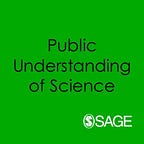The Scientific Sublime: Popular Science Unravels the Mysteries of the Universe
Review by Declan Fahy
The scientific sublime can help scholars examine the carefully-constructed public identities of popular scientists.
The Scientific Sublime offers a new way of thinking about a concept that is deeply rooted in western culture. The sublime traditionally offered a way to explain the sense of wonder and awe we experience when we encounter nature’s vast, complex beauty. The concept has also long been recognised as an analytic term to explain the appeal of popular science, and the thrilling sense of awe we experience when we confront nature as represented in the pages of popular science books.
Gross, whose The Rhetoric of Science (1990) remains an important work in the field, develops the concept through a fresh examination of its intellectual history, and he applies it to explain the popularity of some of the best-known North American popular science writers of recent decades, physicists Richard Feynman, Steven Weinberg, Lisa Randall, Brian Greene, Stephen Hawking, and biologists Rachel Carson, Stephen Jay Gould, Steven Pinker, Richard Dawkins, and E.O Wilson. Gross chose to analyse these writers because their books explained complex science to non-specialists and because the scientists shared, in his view, a common ambition to write big-picture works about origins — of matter, the universe, and humankind.
Gross offers an original history of the sublime. The concept has been most commonly associated with philosopher Immanuel Kant and the literature of Romantic writers, including Byron and Shelley. Their aesthetic and spiritual evocation of nature is part of a tradition Gross calls the “natural sublime” but he expands the sublime from its roots in nature and art to incorporate ideas from science. In his history, the scientific sublime owes its intellectual heritage principally to Adam Smith, a key figure of the 18th century Scottish enlightenment.
The polymath Smith remains a towering figure in economic thought, but he is less well recognised for his contributions to the history and philosophy of science. In his essay, History of Astronomy, Smith described the experience of the sublime as “that rolling of the eyes, that suspension of the breath, and that swelling of the heart” that occurs when we confront a striking natural event, such as a solar eclipse.
Based on Smith’s observations, Gross defines the scientific sublime as, broadly, the wonder we feel when we first encounter a particular phenomenon of the natural world, which is part of a pattern in nature that only science can perceive and explain. This reconfigured conceptualisation is the book’s main contribution to knowledge, marking a theoretical development of the concept, putting the sublime on a materialistic, naturalistic, and scientific basis.
However, this concept is not clearly deployed in individual chapters to illuminate the work of the selected scientists. Each chapter concludes with an argument about how the writer manifested, through their work, a particular variety of the scientific sublime. Feynman, for example, communicated agreed-on science, so he demonstrated what Gross called the “consensual sublime”. Greene advocated for the more uncertain physics of string theory, so he demonstrated the “speculative sublime”. But such conceptual differentiation blurs, rather than clarifies, the book’s well-developed core idea of the scientific sublime.
The most interesting chapters are those on Carson and Wilson, as these show clearly how the writers experienced and conveyed the core idea of the scientific sublime. As Gross demonstrates, Carson evoked the vast beauty of the world’s oceans in her science-rich The Sea Around Us (1950) and Wilson in his co-written Journey to the Ants (1994) conveyed the wondrous construction of an ant’s nest. For me, these chapters best illuminated the scientific sublime, despite the concept being somewhat muddled by Gross labelling Carson’s work as “the ethical sublime”, because it was underpinned by a respect for nature, and Wilson’s endeavours something called “the biophilic sublime”, the scientist’s affection for the biosphere.
The book’s final chapter is disappointing. It does not, as might be expected, tie together the common patterns identified in the core chapters. It is instead an extended foray into the science-versus-religion debate arguing that science and religion can co-exist, concluding with the commonplace notion that science cannot tell us how to live a good life. This reads like an essay on a different topic that has been clumsily fused to the end of this book.
Nevertheless, science communication scholars will find the scientific sublime a useful concept. Gross advances understanding of the appeal of popular science writers, anchoring it in materialist and naturalistic terms. The scientific sublime can help scholars examine the carefully-constructed public identities of popular scientists. The concept, for example, arguably lies at the core of the appeal of British celebrity physicist Brian Cox. His books include Wonders of the Solar System (2010), Wonders of the Universe (2011), and Wonders of Life (2013), showing that the scientific sublime has another type of persuasive appeal — as a marketing tool.
Declan Fahy is an assistant professor at the School of Communications, Dublin City University, Ireland. He is the author of The New Celebrity Scientists: Out of the Lab and Into the Limelight (2015), which examines some of the same case studies featured in The Scientific Sublime.
